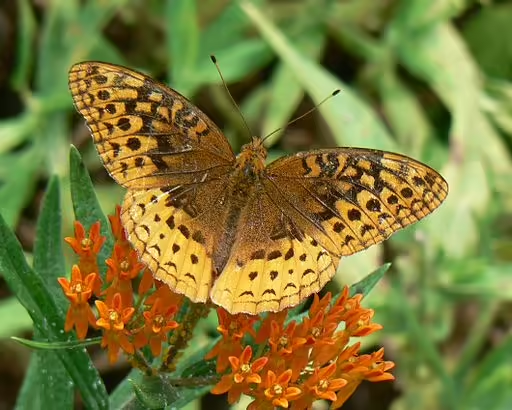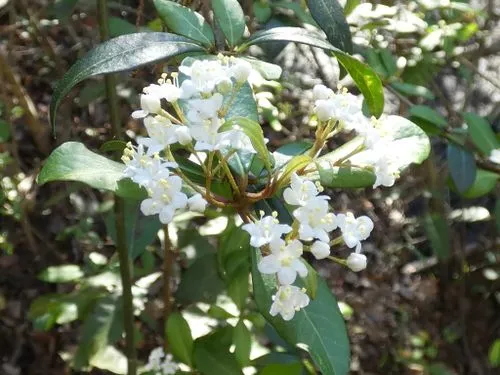Table of Contents for Southern Woodland Violet (Viola hirsutula)
Southern Woodland Violet (Viola hirsutula) is a herbaceous perennial that is found in the eastern United States, except for New York and New England. This plant is a host plant to fritillaries and a number of bees. These plants have medium purple to lavender-purple flowers and distinctive white speckled leaves with pronounced green veins and are found in woodlands that are mesic to dry. This is one of the most attractive violets in the McMullen Gardens.
Taxonomy and Naming of Southern Woodland Violet (Viola hirsutula)


Taxonomy
Southern Woodland Violet (Viola hirsutula) was first named and described by Ezra Brainerd, an American botanist and President of Middlebury College in 1907 (Brainerd 1907). The description was based on a plant from Tryon, North Carolina (GBIF). It has kept this name since. Historically this species has been lumped with either the Carolina violet (Viola villosa) or the common blue violet (Viola sororia), based on the pubescence (Brainerd 1921). This plant is a member of the Violet Family (Violaceae).
With the above stated, this plant is known to hybridize with the common blue violet Viola sororia and the sagittate violet (Viola sagittata) and can make it hard to identify.
Meaning of the Scientific and Common Names
Scientific Name
The genus name, Viola, is from the Latin name for “sweet-scented flowers” (Missouri Botanical Garden). The genus name also derives from the color violet (Online Etymology Dictionary). The species name, hirsutula, is in reference to the hirsute pubescence on the leaves.
Common Name and Alternative Names
The common name refers to the habitat of the plant. Other alternate names, such as wood violet (Vascular Plants of North Carolina) and southern wood violet, are also in reference to the habitat.
Physical Description

- Plant Type: Herbaceous perennial
- Height: this plant is stemless (acaulescent) and instead grows in clumps on the ground.
- Leaves: alternate, simple, crenate (sometimes serrate) leaves that range from 3 to 6 inches in length and width. The leaves have a white fuzzy pubescence on the top that give it a white speckled appearance and which highlights the green veins.
- Flower color: medium purple to lavender with a red tinge. Like other violets, this species, has two flowers, one on the ground (Cleistogamous) and one above ground (Chasmogamous) or the one you see.
- Blooming period: March to June
- Fruiting type and period: capsule that matures in the summer.
Range Map of Southern Woodland Violet (Viola hirsutula)

This species is native to the eastern United States except for New York and New England. It is considered to be rare in Indiana and Mississippi.
Habitat

This violet is found in a variety of habitats in wooded areas. Most often they are rocky dry to dry-mesic areas, slopes, or in bottomlands. The Alabama Plant Atlas states that it can also grow on roadsides and in cemeteries (Alabama Plant Atlas).
Hosted Insects

Violets (Viola spp.) are hosts to a number of fritillary butterflies. This violet species is not a host to a specific species, but most fritillaries will use it.
Other Supported Wildlife

Violets (Viola spp.) are important nectar plants for bees and other insects.
Frequently Asked Questions
What other violets are similar to this species?
Southern woodland violet is similar to both the common blue violet and the Carolina violet and in fact was once lumped with both. The common blue violet has a pubescent petiole, while the other two species do not. The Carolina violet has a bearded spurred petal, while the southern woodland violet does not. This species is also similar to Walter’s Violet (Viola walteri), but Walter’s violet is mat forming and the southern woodland violet grows as a single plant (Alabama Plant Atlas).
Does this species have any ethnobotanical uses?
The North American Ethnobotany Database does not specifically list this species, but violets in general have been used as vegetables and for skin and eye diseases.
Gardening with Southern Woodland Violet

Hardiness
We were not able to find any sources with the zones of this species. However, going by the native range it is probably hardy within zones 5 to 9. It grows in the McMullen House Bed & Breakfast Garden and is native just south of the garden and we are in zone 5. If your garden is within these zones and you have the right soil and moisture conditions it is likely you can grow this plant.
Cultivars
- ‘Purpurea’ : has dark foliage
- ‘Alba’ : has silvery leaves with dark veins.
Optimal Conditions
This violet likes places that have part shade to shade and have mesic to dry soils. In its native habitat, it seems to like rocky areas.
References
- Brainerd, Ezra. 1907. The Older Types of North American Violets – I. Rhodora 9: 93-98.
- Brainerd, Ezra. 1921. Violets of North America. Free Press Printing Company: Burlington. Vermont Agricultural Experiment Station Bulletin.


